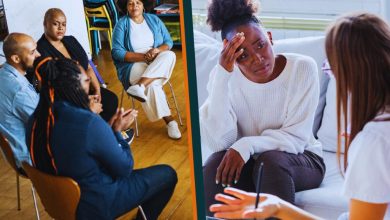Understanding the Mental Health Awareness Color Code

Introduction:
Understanding the Mental Health Awareness Color Code
Sometimes colors speak more loudly than words. They can tell stories without acting. Colors are essential in the field of mental health. They enable us to grasp and discuss many mental health concerns. Let’s examine how these colors are transforming life and venture into the rainbow of the Mental Health Awareness Color Code.
.
The mental health awareness color code functions as a kind of hidden language. It enables people to share knowledge and demonstrate support. Every color represents something unique. It’s a means of expressing “I care” or “I understand” without words. As we learn to talk about mental health more candidly, this code becomes more relevant.
In this color system, green is rather prominent. It is generally about Mental Health Awareness Color Code
. Consider it akin to being the team captain. Seeing green ribbons or clothing demonstrates support for all types of mental health. For everyone handling mental health issues, it’s like a large, cozy hug. Green argues, “Mental health is okay to discuss. We are all in this together.”
Blue also shows up too often. It’s the color used to raise Mental mental Awareness Color Code of depression. Feeling blue is related to a crucial cause, not just a catchphrase. Blue tells us there is assistance available and that depression is a real condition. It’s like a subdued pat on the back saying, “It’s okay to not be okay.” For this reason, someone wearing blue might be saying, “I’ve been there too” or “I’m here to listen.”
Purple sets the stage for attention span problems.
It’s striking and vivid, much like how different brains function. Purple means, “Hey, Mental Health Awareness Color Code let’s understand each other better.” It’s a royal color for a royal endeavor to assist folks with attention issues. Purple informs us that many points of view are worthwhile and deserve celebration.
Silver glows for raising knowledge of eating disorders.
It’s robust and elegant, Mental Health Awareness Color Code much like the individuals battling these difficult challenges. “You’re valuable and beautiful,” Silver says softly. For people battling food and body image, it speaks of hope and healing. Every day, silver demonstrates the will it takes to overcome obstacles.
Orange arrives on the scene to raise awareness of self-harm. Like those overcoming this obstacle, it is bold and courageous. Orange yells, “You’re strong, and you can get through this!” A difficult subject calls for a warm color. Orange reminds us to be reachable and help others who might be hurting.
Teal represents anxiety problems.
It’s chilly and quiet, exactly what many people with anxiety want. Mental Health Awareness Color Code Take a long breath, says Teal. You possess this. This color calms turbulent thoughts. When you see teal, consider it a reminder to treat people with worry patiently and sympathetically.
Yellow rays are brilliant for suicide prevention.
It’s cheerful and hopeful, guiding one through trying circumstances.Mental Health Awareness Color Code Yellow calls out, “Hold on! There is light ahead! This is a happy color for a rather serious reason. Yellow tells us that support and hope abound, even in the worst of times.
Red blazes for consciousness about drugs.
Like the struggle against addiction, it is intense and passionate. Red roars: Mental Health Awareness Color Code “You surpass this. Continue battling! For fierce combat, this color is striking. Red emphasizes how urgently addiction must be addressed and how much support those in recovery need.
Gray stands in for borderline personality disorder.
Mental Health Awareness Color Code complicated and profound, just like the feelings involved. Gray hushes, “You’re not alone in this.” For a not-quite-subtle fight, this is a subdued color. Gray reminds us that, although they are all legitimate, not all battles are obvious.
Pink flowers also raise awareness of eating disorders.
Like people in recovery, Mental Health Awareness Color Code is gentle but powerful. Pink pledges, “Everybody is beautiful.” It’s a soft hue for a difficult path. Pink inspires us to embrace body positivity and question negative beauty standards.
Black stands tall for occasionally depressed people.
Mental Health Awareness Color Code forceful and clear, much like despair might feel. Black says, “This is real, and it matters.” For a major problem, this is a serious color. Black reminds us of the depth of despair as well as the need to get in touch.
White excels generally in mental wellness.
Like a fresh start, it is pure and infinitely possible. White whispers, “Everyone has hope.” It’s a blank canvas, ready for fresh starts. White exhorts us, regarding mental health, to retain an open mind and heart.
These hues serve purposes beyond just aesthetics.
They start the conversations. They disrupt the silence. They offer help. Wearing a colored ribbon tells someone, “I am here. I have concerns. Let’s converse. This is a basic approach to having a significant impact.
Still, it’s not only about color choices.
Mental Health Awareness knowing their significance. Learning the color code helps us notice signs. We grow to be reachable. We start to be there for one another. It’s like picking up a new language—the language of empathy and encouragement.
Using these hues, schools teach children about the the Mental Health Awareness Color Code. They might set up special days where everyone dresses in green to emphasize mental health issues. This teaches young people early on that asking for help and discussing emotions are normal.
The color code is also used in offices to help employees.
Their teal decorations could be a statement of concern for anxious staff members. Alternatively, they might use orange ribbons to spread awareness about self-harm. This fosters a better working atmosphere.
These hues are frequently used in the materials and decorations of hospitals and clinics. It helps patients feel supported and understood from the moment they arrive. It’s like a little statement: “We get it, and we’re here to help.”
The hues occasionally blend.
That’s OK. Mental wellness is difficult. One does not usually find one clear color. The mix illustrates how twisted our minds might be. It demonstrates that not fitting in one box is quite acceptable. Someone might indicate support for several concerns by wearing a bracelet with multiple colors.
The color code, too, helps to break the stigma. It brings invisible struggles to life. Whispers become yells in response. Said another way, “This is real, and we’re not hiding anymore.” People are reminded that mental health influences everyone when they see these colors.
Still, colors are only the beginning.
They invite more in-depth conversations. Their narrative is not the complete one. They open the first page of a large book on compassion and understanding. The actual job is done in the next interactions and deeds.
The mental health color code now finds fresh life on social media. Individuals show support by wearing colored ribbons or altering their profile images. This raises awareness over enormous distances. It’s like an online embrace with global reach.
Certain towns and cities have murals painted in these hues. That’s a great, lovely way to put it: “Our community cares about mental health.” These paintings start to be sources of discussion and reminders of the need for mental health.
These colors are frequently used in runs and walks, among other events. At a mental health awareness run, you could find an ocean of green shirts. Alternatively, a mass of yellow balloons is meant for suicide prevention. These gatherings unite individuals and create an arresting visual statement.
The color code is also being used in the work of artists.
They make digital art, sculptures, and paintings examining mental health issues. This enables fresh approaches to expressing complicated emotions. It’s as if you could see and touch emotions.
Fashion designers are getting involved. They’re designing clothing lines with these significant color combinations. It’s a means to show your support and initiate mental health discussions anywhere you go.
Even food is starting to participate actively. Bakers could create blue-frosted cupcakes to raise awareness of sadness. Bartenders might design purple cocktails for Awareness of Attention Disorders Month. It’s a delicious approach to getting the word out.
These colors are occasionally used by sporting teams in special games or events. They could employ colorful equipment or don unique shirts. This raises mental health consciousness among a whole different audience.
Sometimes public buildings and monuments flash in these colors during holidays or months of celebration. Imagine a well-known bridge glowing green for mental health awareness. Mental Health Awareness Color Code a rather large, brilliant approach to starting conversations.
Research is benefiting even from color coding. Researchers are learning more about various mental health disorders using color preferences. It provides fresh approaches to viewing and handling mental health concerns.
As we wind down, consider the colors in your surroundings. What are their opinions? What emotions do they arouse? Perhaps now you will view mental health awareness from a fresh perspective. The next time you notice someone sporting a colored ribbon or bracelet, you will know why.
Remember,
the color code for Mental Health Awareness The Code is continually evolving and expanding. As our knowledge of many disorders grows, new hues could be incorporated. This is a live language that enables daily improved understanding and assistance amongst us.
Finally:
The mental health awareness color scheme serves purposes beyond mere aesthetic appeal. This is a potent tool that alters our perceptions of, knowledge of, and support for mental health. Every color relates a tale of hardship and optimism, of obstacles overcome and conflicts resolved. Learning this code helps us become better people, friends, and family members. Mental Health Awareness Color Code We come to see the daily, invisible battles many people wage.
These hues remind us that everyone’s mental health counts, not only that of people diagnosed with a disorder. They inspire us to be compassionate, to listen without judgment, and to provide help when called upon. They enable the barriers of stigma and secrecy surrounding mental health to be broken down after too much neglect.
Let’s carry these hues in our hearts and brains as we move forward. Let’s paint a world where everyone feels appreciated, supported, and understood by using them. In a society where seeking assistance is considered a sign of strength rather than weakness, In a world in which physical health takes second place to mental wellness,
Knowledge of Mental Health Awareness Color Code is only a starting point. It’s a basis for more in-depth talks, improved knowledge, and actual transformation. Learning to speak this vibrant language of compassion helps us walk toward a better, more encouraging future for everybody.
Let’s keep communicating, keep learning, and keep encouraging one another. Ultimately, we are all participants in this vibrant, intricate, and wonderful human experience together.
FAQ:
1. Why would one use color to promote mental health awareness?
One can readily identify and remember colors. They simplify difficult subjects by helping initiate discussions and providing nonverbal support, thereby enabling words.
2. Are these hues universal and found everywhere?
Although many are well known, some could vary depending on the nation or company. It’s advisable to ask local mental health groups for specific connotations in your area.
3. Should I not have a mental health problem personally, may I still employ these colors?
Indeed! Choosing or using these colors helps to raise awareness. It’s a means for friends to demonstrate their compassion and desire to be of service.
4. How might the color code benefit others in my neighborhood?
After learning what the colors represent, find ways to include them in community events or decorations. They can also be starting points for a talk on mental health.
5. Are there other ways I can show support than by donning ribbons?
Though you can use the colors in numerous ways—clothing, social media posts, art projects, or simply just discussing their significance with others—ribbons are prevalent.
6. Is there a hue for every single mental health disorder?
While many significant conditions have a color, not everyone does. Certain hues reflect a more general spectrum of mental health issues.
7. In mental health awareness, can the same hue imply multiple things?
sometimes. Pink and silver, for instance, can both stand in for eating problems. Context and the particular company applying the color might help define the meaning.
8. How often do these color interpretations evolve or change?
Though the basic meanings are consistent, as awareness of certain diseases increases, more colors could be included. It’s a changing language of support.
9. What would happen if I accidentally confused the colors or their interpretations?
Relax, though! Showing your love and a desire to learn is crucial. Ask someone for guidance or constantly search for the proper meanings.
10. How can I find out more about mental health than only color awareness?
The colors are fantastic. From there, search for neighborhood mental health organizations, go to awareness events, or speak with a mental health expert to learn more.



